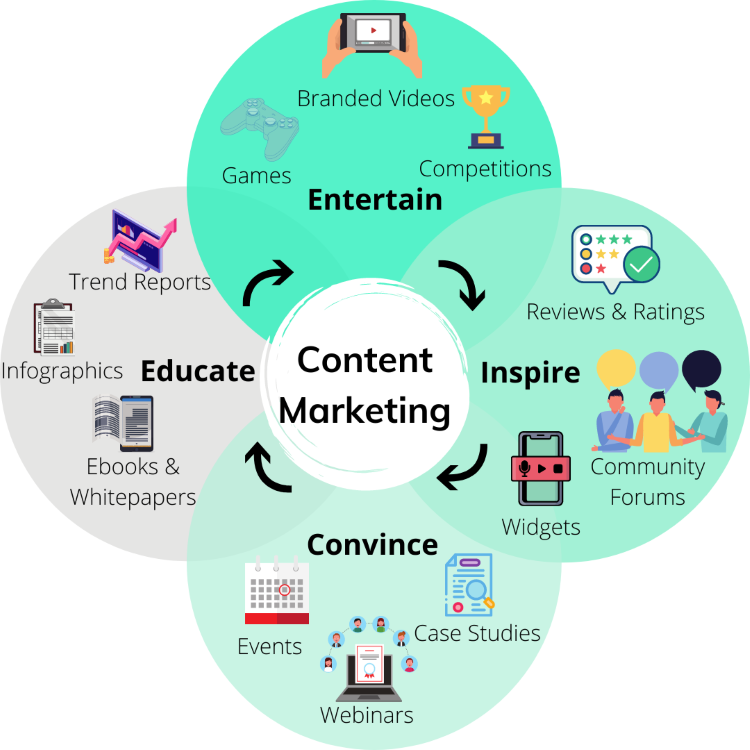Content Marketing
What is content marketing, why should you focus on it, and what forms can content take both on and away from your website? We’ll explain all of this, as well as how to measure and report on the success of your content marketing, to help you to reach your digital marketing goals.
Free Ultimate Guide To Content Marketing eBook
We'll show you how you can breathe new life into your words with on-brand content, helping you connect with your customers, writing with purpose and continuously measuring results. Download our free Ultimate Guide To Content Marketing eBook now to ensure your website is driving traffic and conversions to help your business grow.
x
Contents
- What is Content Marketing?
- The Benefits of Content Marketing
- Types of Content Marketing
- Blogging
- Website content
- Product descriptions
- Infographics
- Video
- Podcasts
- User-generated content
- How to Measure and Report on the Success of Your Content Marketing
- Conclusion
What is Content Marketing?
Image

Content marketing is a long-term marketing strategy which can help you to build strong relationships with customers to gain more sales and leads and reach your goals. Content marketing includes the creation, curation and distribution of many different types of online content. It feeds into other marketing disciplines such as SEO, social media and email marketing. The four purposes of content are to entertain, to inspire, to educate and to convince.
To start you off, take a look at our blog post SilverDisc Guide For Marketing Managers: Building Your Content Marketing Skillset.
The Benefits of Content Marketing
The saying “content is king” has been around for a long time, and for good reason - there isn’t very much you can do online without having at least a little content to share. This is especially true for your website content, because anything you do in other channels, such as PPC, social media and email marketing, all need to lead back to your website because that’s usually where visitors turn into customers and make purchases or other conversions. Read our blog post to find out Why Your Website Should Be The Central Hub For Your Online Activity.
Here are a few benefits of content marketing:
- Content marketing helps you to improve your SEO. Google loves long-form content that’s new and useful or entertaining for your visitors. Great content can help you to climb the rankings on Google’s results pages, but it’s not all about rankings - whether your SEO goals are to bring in more visitors or increase sales, content can help with this. Content could help you with link building too, which is another important SEO strategy. Find out more about link building and content here: How You Can Use Content Marketing As A Link Building Strategy.
- Content marketing can help you to increase visibility on SERPs. Did you know that you can optimise your onsite content to improve its appearance on search engine results pages? Featured snippets and answer boxes appear at the top of SERPs and you can format your content in a way that helps Google put you in these “position zero” listings. This can also help you to get found through voice search. Find out more in Moz’s comprehensive guide on how to optimise for featured snippets.
- Content can help you to increase visibility and strengthen your brand. The more content you have and share online, the more eyeballs you could get on your website and the more well-known you could become in your industry - making you the go-to provider for your customers’ needs.
Here are some blog posts about content and branding to help you on your way:
- How can content marketing help strengthen your brand?
- 4 Lessons From Cadbury on How to Leverage the Power of Your Brand Online
- How Rich Content Can Increase Your Site’s Visibility
- Similarly, it can help you to build relationships with customers. Your content may help to solve people’s problems, provide them with more knowledge, enable them to make a purchasing decision or simply give them a way to pass the time. By providing this great content, you’re setting yourself up to be an expert in your field and somewhere for your customers to return to again and again.
- Content can increase customer lifetime value by keeping you at the front of people’s minds when they need your product or service.
- Finally, it can help you to integrate your marketing channels, creating a synergy between all of your channels and strategies. Strong, consistent messaging across all platforms can help to strengthen your brand, build trust and cement your position at the forefront of customers’ minds.
What are the Different Types of Content Marketing?
Let’s take a closer look at the different types of content marketing available to you.
Blog Posts
Blog posts are perhaps one of the first things many people think of when considering the different types of content marketing. When blogging, it’s important to write articles you think will entertain or inform your audience, while keeping your messaging in-line with your brand and promoting your products or services in a subtle yet effective way. It’s also important to blog regularly, rather than sporadically - after all, the rest of your digital marketing system may depend on you providing new content consistently. Don’t forget about SEO, too - here are 12 Ways To Make Your Blog Posts More SEO Friendly.
Read our blog posts below for more great tips on blogging:
- 5 Ways You Can Improve Your Blog to Generate More Online Sales
- How To Write Regular Blog Posts and Stay Organised
- A Blog About Blogging
- 5 Ways To Create Content For Your Website Faster
- How To Optimise and Refresh Your Old Website Content
On-page Copy
This is the main content on your website - think your homepage, about us page, contact us page, headers, footers, service pages and so on. Your website copy is your first chance to showcase your products, services and business as a whole, so you need to carefully consider your wording and the first impressions you would like to make. This includes ensuring your spelling and grammar is perfect, that you’re targeting your audience appropriately (see our blog post Are You Speaking Your Customers’ Language?), and that you’re steering people towards making a conversion. It should also be SEO friendly.
Product Descriptions
For online retailers, product descriptions are one of the most important parts of a website. They need to explain the product and its benefits fully, and they will ideally be much more than a couple of sentences or bullet points and a photo. This is your chance to sell your product - so don’t squander the opportunity to really sell it! Read more in our blog post Creating Content: Writing Effective Product Descriptions.
Email Marketing
Though not part of the website itself, email marketing does form a part of content marketing and may point to more content on the website itself. Email marketing may cover newsletters containing company updates and blog articles, or mailshots for offers and sales. Here are 5 Ways To Write Better Newsletters.
Infographics
Infographics are both visually appealing and informative, often containing high-level facts or statistics about a particular subject, alongside eye-catching images. If done well, they can be very shareable, lending themselves well to social media.
Video
Video content is easy to digest, and some users may prefer to watch a video over reading written content. It may be worth experimenting with these different content types to discover which provides you with the best return on investment.
Read our blog posts for more tips on video marketing:
- Early Digital Adoption Series Part 3: The Video Edition
- Video Content Creation: Should Your Business Be Using IGTV for Marketing?
- Create Great Video Content With Lumen5
Podcasts
Podcasts have become increasingly popular in recent years, and they enable you to reach people while they are on the go. A podcast allows you to tell your story, engage with customers and collaborate with others in your industry to entertain, inform and inspire listeners.
User-Generated Content
Case studies, testimonials and reviews are just some examples of user-generated content you could add to your website. It’s minimal effort on your part but provides your website visitors with information they can trust from your real-life existing customers. Follow the links to each of these types of user-generated content to find out more about how to do them well.
Planning Your Content Marketing Strategy
Creating A Content Calendar
As with all marketing strategies, it takes a little planning to get your content marketing ducks in a row. A content calendar can help you to organise your ideas, plan your content across a range of different channels, and take a more holistic approach to your writing and the stories you tell.
Here are two articles to help you plan your blog posts, social media and more:
- Do I really need to make a plan for my content marketing strategy?
- How To Align Your Blog, Social Media and More With A Content Calendar
Writing For Your Audience
It’s also important to ensure you’re planning to engage with the correct audience. Consider creating personas to help guide you towards talking to your target audience in a way that will engage them - this will enable you to keep one or two specific “characters” in mind and always feel like you are talking directly to them. Make sure you consider tone of voice and the right language to use to connect with your potential customers. You may find it useful to create a style guide to ensure all of your content is consistent in helping you to match this tone and language. Again, our blog post Are You Speaking Your Customers’ Language? may help with this.
As well as considering who you are talking to, it’s important to bear in mind what you would like them to do. Planning your content strategy means ensuring each piece of content serves an important purpose in the buying journey to bring your customers closer to conversion. This diagram from Hubspot helps explain which content types can be useful during three stages of the buying journey: awareness, evaluation and purchase.
Finding Ideas For Content
Of course, a big part of planning is deciding what you actually want to write about. Whether you’re starting from scratch of you’re all out of inspiration, we have two blog posts that can help you to fill up your well of ideas:
How to Measure and Report on the Success of Your Content Marketing
As with all marketing strategies, it’s important to know whether the hard work you’re putting in is working. And to know if it’s working, you need to know what you want to achieve from your content marketing. That means you need to set some measurable goals, then monitor them, report on them and use that information to set new goals and continue reaching new heights. An example of a goal for content marketing may be a certain number of unique visitors, sales, enquiries or revenue over a set period.
Conclusion
Content is threaded through so many parts of the digital marketing system, it’s no wonder we can do so many different things with it and use it within so many marketing channels. Good content will entertain, educate or inspire website visitors, and convince them to become your customers. Plus, an effective content marketing strategy will involve setting goals, measuring performance and continuing to set new goals and striving to do better. Although the form it takes and the trends that arise over time may change, content will always be king.
Free Ultimate Guide To Content Marketing eBook
We'll show you how you can breathe new life into your words with on-brand content, helping you connect with your customers, writing with purpose and continuously measuring results. Download our free Ultimate Guide To Content Marketing eBook now to ensure your website is driving traffic and conversions to help your business grow.
x



